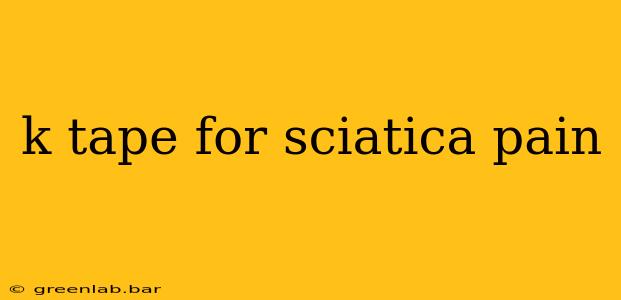Sciatica, that sharp, shooting pain radiating down your leg, can be debilitating. While medical attention is crucial for diagnosis and treatment, many find relief through complementary therapies like Kinesio Tex taping, often called K taping. This guide explores how K tape can help manage sciatica pain, its application techniques, and important considerations.
Understanding Sciatica and its Causes
Sciatica isn't a condition itself but a symptom, usually stemming from compression or irritation of the sciatic nerve. This nerve, the largest in the body, originates in the lower back and branches down through the buttocks and legs. Several factors can contribute to sciatica, including:
- Herniated disc: A bulging or ruptured disc in the spine can press on the nerve.
- Spinal stenosis: Narrowing of the spinal canal puts pressure on the nerve.
- Piriformis syndrome: Irritation of the sciatic nerve by the piriformis muscle.
- Spondylolisthesis: A vertebra slips forward over the bone below it.
- Pregnancy: Hormonal changes and increased weight can strain the lower back.
How K Tape Can Help with Sciatica
Kinesiology tape offers a non-invasive approach to sciatica pain management. Its elastic properties allow for a wide range of motion while providing support and reducing pain. The purported benefits include:
- Pain reduction: The tape's lift on the skin can alleviate pressure on the nerve and reduce pain signals.
- Improved blood circulation: The tape's application encourages better blood flow to the affected area, facilitating healing.
- Muscle support: K tape can provide support to weakened or strained muscles in the lower back and hips, contributing to improved stability and posture.
- Reduced inflammation: By improving lymphatic drainage, the tape may help reduce inflammation around the sciatic nerve.
It's crucial to understand that K tape is not a cure for sciatica. It's a supportive therapy that can complement other treatments recommended by your doctor or physical therapist.
K Tape Application Techniques for Sciatica
Applying K tape effectively requires proper technique. While numerous methods exist, some common applications for sciatica pain relief involve:
1. Lower Back Support
This technique focuses on supporting the muscles of the lower back, reducing strain on the sciatic nerve. The tape is typically applied in an "I" shape along the paraspinals, extending from the sacrum to the lower thoracic spine.
2. Gluteal Muscle Support
The piriformis muscle, located in the buttock, can sometimes compress the sciatic nerve. K tape applied to the gluteal muscles can help alleviate this compression and reduce pain. This often involves an "X" or "Y" shaped application.
3. Hamstring Support
Tight hamstrings can exacerbate sciatica pain. Applying K tape to the hamstrings can help improve flexibility and reduce strain on the nerve.
Note: It's highly recommended to consult with a qualified healthcare professional or certified Kinesio taping practitioner for proper application techniques. Incorrect application can be ineffective or even harmful. Watching instructional videos can be helpful, but professional guidance is essential for optimal results.
Important Considerations
- Consult your doctor: Before using K tape for sciatica, consult your doctor to rule out serious underlying conditions and ensure it's appropriate for your specific situation.
- Professional application: While you can learn to apply K tape yourself, professional application is often recommended, especially for initial treatments.
- Skin sensitivity: Ensure you have no allergies to the adhesive used in the tape. Proper skin preparation is crucial.
- Tape removal: Remove the tape gently to avoid skin irritation.
- Not a standalone treatment: K tape should be considered a supplemental therapy, not a replacement for medical advice or prescribed treatments.
Conclusion
K tape can be a valuable tool in managing sciatica pain, but it's not a miracle cure. Combining it with other therapies, under the guidance of healthcare professionals, offers the best chance for effective and long-lasting sciatica pain relief. Remember, seeking professional advice is paramount for accurate diagnosis and a tailored treatment plan.

